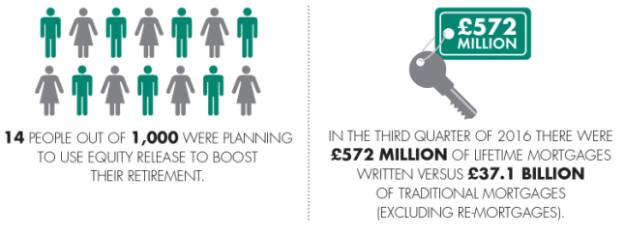
Article 1 / 4
Guide to using property to fund retirementHow can equity release be used to fund retirement?

Equity release can be one way for those reaching retirement to fund their activities and needs in later life.
What might have once been seen as a fairly niche product has recently seen a surge in interest, as people try to find new ways to unlock the value of their property.
The Equity Release Council (ERC) reported growth in the value of equity release lending was £701m in the second quarter of 2017, which means the value of lending has climbed by more than a third when compared to the second quarter of 2016.
Of the 16,000 customers supported by ERC members between April and June, 8,454 took out new equity release plans - a 27 per cent increase year-on-year.
It appears there is more demand than at any other time for equity release.
Figure 1: Housing wealth's role in retirement planning

Source: Old Mutual Wealth, Tisa
Stuart Wilson, channel marketing director at more 2 life, observes: “There are numerous growth drivers affecting this market, but the introduction of pensions freedoms has been one of the biggest revolutions the market has seen.
“These new rules provide customers with increased flexibility and myriad ways to access their pension pots. This will undoubtedly lead to more older homeowners looking towards equity release as a complement to, or even a primary funding asset for, retirement.”
Releasing equity
Alice Watson, head of marketing at Retirement Advantage Equity Release, explains how it works: “Equity release allows UK property owners aged over 55 to release some of the cash stored up in their property without needing to move.
“The money released is tax-free and can be spent on whatever the property owner chooses: for example, clearing mortgages or credit cards, gifting to family, or making house and garden improvements.”
How much is released from the property will depend on a number of factors, including the value of the property, the age of the customer and how much they want to borrow.
Ms Watson notes: “The money customers release won’t be paid back until they or the last remaining borrower either dies or moves permanently into long-term care.”
Lifetime mortgages are proving to be the most popular form of equity release, partly due to recent product innovation but also because customers continue to own their property while releasing money from it, she points out.
“And, as long as customers abide by the terms and conditions of the loan, their property will never be repossessed,” Ms Watson adds.
Protecting customers
Indeed, there are a number of protections in place for those who choose to release equity from their property.
Dean Mirfin, technical director at Key Retirement, points out: “Certainly any provider who offers lifetime mortgages accredited by the ERC must come with three guarantees as a minimum.
“The first is the right to live in your home for the rest of your life. The second is the right to move and take the loan with you, so for the loans to be portable. There is a caveat to that, which is that the property you’re moving to must be acceptable.
“The third one is all of these loans must come with a no negative equity guarantee, so that whatever the loan accrues to, no matter what, you can never owe more than the eventual value of the house.”
There is also some flexibility when it comes to repaying the loan, as Mr Mirfin explains.
“In terms of repayment, clients have basically two options or a combination of the two. The first is they can pay the interest every month but with a fallback that if they ever either can’t afford to pay or don’t want to pay it anymore, it can convert to roll-up interest,” he notes. “They can switch from serviceable to roll-up anytime.
“Alternatively, from day one you can have roll-up – so every month the interest you would have paid is added to the debt and basically that compounds over time. At current interest rates, typically the loan would double round about every 16 years.”
The average lump sum released by clients through later life lending is around £70,000, according to Mr Wilson.
Equity release is increasingly being used to pay off interest-only mortgages and has typically been used as a way of funding home improvements.
“The lump sum generated from unlocking housing wealth can help to consolidate existing debt, and reduce or even eliminate regular payments being made to mortgage lenders and credit card providers, for example, thus freeing up retirees’ income streams,” Mr Wilson says.
“With defined contribution retirement pots being around £30,000 to £40,000 on average, customers can often lay their hands on as much as two or three times that amount via equity release.”
He continues: “Additionally, not only can accessing tax-free cash from housing equity be more tax efficient than using income from pension funds, but by delaying the need for an annuity purchase into later life, clients may be entitled to higher income streams through enhanced annuities.”
More flexible offerings
Flexibility has been introduced over the years into the equity release market, with more features available to customers now.
Mr Mirfin highlights some of these, such as the drawdown facility now offered by some equity release providers.
“What drawdown does is pre-agree the overall facility you can have, in terms of the loan you can have and you can take that over time,” he explains. “So you’ll take an initial amount and then you can come back as and when you want to and take further withdrawals.”
Other types of features are inheritance protection, for those who want to leave some of the value in their property for inheritance purposes, and downsizing protection.
Ms Watson says Retirement Advantage Equity Release introduced two early repayment charge waivers in June this year.
"Our downsizing protection gives customers peace of mind if they’re considering moving home in the future, because if they decide to downsize after five years they will not need to pay an early repayment charge, " she explains.
"Similarly, customers will not need to pay an early repayment charge if they decide to repay their lifetime mortgage within three years of one of the borrower dying or moving into long-term care."
Mr Mirfin advises: “With certain providers, if you want every single option available to you, then chances are you’ll end up with one of the most expensive lenders.”
He believes it is important to establish with clients what features they really want and are likely to use so they are not paying for an add-on they will never need.
Not for everyone
Most in the industry agree equity release or lifetime mortgage products are not the answer for everyone, so it is crucial for those who are interested to seek advice and perhaps consider all the options.
Mr Mirfin says he encourages people to discuss the option with their family and also to consider whether they have any other savings they can draw on first. Another type of borrowing may even be more suitable, depending on their circumstances, such as a personal loan or using a credit card.
While there is no single view of what a typical equity release customer looks like, he acknowledges generally it might suit those who are “asset rich and cash poor”.
“If the bulk of their wealth, if not all of it, is in their home and they need money, that is who this typically is going to be suitable for,” he suggests. “But with lots of caveats around it. It may well be sensible but there could be better ways of doing it. Should you be doing anything at all and is a lifetime mortgage the most suitable way of doing that?”
Steve Ellis, managing director at Legal & General Home Finance, agrees: “Of course, these products aren’t for everyone. Advice remains essential for anyone considering releasing equity, and it’s important they are given a holistic overview of all the options open to them when planning later life, such as downsizing.
“However, for people who lack the funds to support them in retirement, but who do not want to move, perhaps because they cherish the memories of raising a family in that home, a lifetime mortgage could be the right solution.”
The knowledge people have the ability to free up money from their home may provide retirees with options they were not previously aware were available to them.
But getting advice from a financial adviser is vital in order to make the right decision.
Ms Watson suggests: “Rather than labelling a pension for retirement, and property for inheritance, thinking more holistically and discussing options with a financial adviser will help customers understand what options work best for their circumstances.”
eleanor.duncan@ft.com



